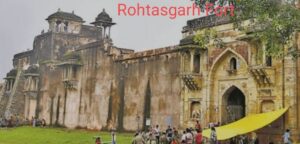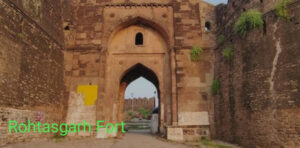Rohtasgarh Fort, an iconic historical monument, stands as a testament to India’s rich and diverse past. Located atop the Kaimur Hills in Bihar, this majestic fort is one of the largest and oldest hill forts in the country. Built during the medieval period, Rohtasgarh Fort not only showcases a blend of Afghan and Mughal architecture but also offers breathtaking views of the surrounding landscape. With its rich history, architectural grandeur, and cultural significance, Rohtasgarh Fort is a must-visit destination for history enthusiasts and travelers.

1. History of Rohtasgarh Fort
The history of Rohtasgarh Fort dates back to ancient times, though the fort gained prominence during the rule of Sher Shah Suri in the 16th century. Originally built by Raja Harishchandra in the 7th century, the fort was used as a stronghold to protect the kingdom from invasions. However, it was during the reign of Sher Shah Suri, the founder of the Suri Empire, that the fort became a strategic military base. Sher Shah recognized its potential as a defensive fortress due to its elevated position, which provided a commanding view of the surrounding areas.
Throughout its history, the fort witnessed several battles and changing dynasties. After Sher Shah Suri’s reign, the Mughals, under Emperor Akbar, captured the fort, further strengthening its defenses. The fort remained under Mughal control for centuries, but after the decline of the Mughal Empire, it eventually fell into disuse and abandonment. Despite the fort’s current state of ruin, its historical significance remains intact.
2. Architecture and Design of Rohtasgarh Fort
The architecture of Rohtasgarh Fort is a striking blend of Afghan and Mughal styles, reflecting the various rulers who controlled the fort over the centuries. Spread across an area of approximately 28 square kilometers, the fort is renowned for its robust defensive design and strategic layout.
One of the most notable features of the fort is its massive stone walls, which are nearly 4 kilometers long and stand at an impressive height. The fort has several gates, each named after significant figures, including the Hathiya Pol (Elephant Gate) and the Sohil Gate. The fort also contains numerous palaces, temples, mosques, and other structures that speak to its historical and cultural diversity.
Key structures within the fort include the Rohtash Temple, dedicated to Lord Shiva, and the Hansh Khan’s Mausoleum, a beautiful example of Islamic architecture. The fort’s water management system, which includes step wells and reservoirs, is another remarkable feature, showcasing the advanced engineering of that era.
3. The Fort’s Decline and Restoration Efforts
Despite its former glory, Rohtasgarh Fort gradually fell into decline after the Mughal Empire’s fall. With the shifting political landscape and the rise of the British colonial rule, the fort lost its strategic importance. Over time, the fort was neglected and eventually became overgrown with vegetation, leaving it in a state of disrepair.
In recent years, however, efforts have been made to restore and preserve this historic site. The Archaeological Survey of India (ASI) has taken steps to conserve the fort, although much of the site remains in ruins. Preservation efforts are vital not only to protect the architectural heritage but also to maintain the cultural significance of this historic site for future generations.
4. The Scenic Beauty of Rohtasgarh Fort
Apart from its historical importance, Rohtasgarh Fort is renowned for its scenic beauty. Nestled atop the Kaimur Hills, the fort offers panoramic views of the Son River and the lush green valleys that surround it. The area around the fort is rich in biodiversity, with dense forests, waterfalls, and wildlife making it a paradise for nature lovers.
The fort’s location, at an altitude of nearly 1,500 feet above sea level, provides visitors with breathtaking vistas, especially during sunrise and sunset. The natural beauty of the fort’s surroundings, combined with its historical significance, makes it a popular destination for trekkers, photographers, and adventure seekers.

5. Tourist Information
Rohtasgarh Fort is a popular tourist destination, attracting visitors from across the country. The best time to visit the fort is during the winter months, between November and February, when the weather is pleasant and conducive for exploration. The summer months can be quite hot, making it difficult to explore the vast expanse of the fort.
There is no entry fee to visit the fort, but hiring a local guide is highly recommended to fully appreciate the historical and architectural significance of the site. The trek to the fort can be challenging, so visitors should wear comfortable clothing and sturdy shoes. It’s also advisable to carry water and snacks, as there are limited amenities available near the fort.
For accommodations, visitors can stay in nearby towns such as Sasaram or Dehri, which offer a range of hotels and guesthouses. Sasaram is also home to the tomb of Sher Shah Suri, another important historical site worth visiting.
6. Rohtasgarh Fort’s Cultural and Historical Legacy
Rohtasgarh Fort holds a special place in the cultural and historical narrative of India. Over the centuries, the fort has been a symbol of power, resilience, and architectural brilliance. It has inspired numerous local legends and folklore, which continue to be passed down through generations.
The fort has also played a significant role in shaping the local culture of Bihar, influencing everything from literature to music. It is frequently referenced in historical texts and has been the subject of several documentaries and research papers. In recent years, efforts have been made to promote Rohtasgarh Fort as a key site in Bihar’s tourism landscape, with hopes of attracting more visitors and preserving its legacy.
Conclusion:
Rohtasgarh Fort is not just a historical monument; it is a window into India’s rich past. Its impressive architecture, strategic location, and deep historical roots make it a must-visit destination for anyone interested in India’s medieval history. The fort’s cultural significance and its scenic beauty also make it a great place for travelers seeking both history and nature.
As a symbol of India’s diverse cultural and architectural heritage, Rohtasgarh Fort stands tall, despite the ravages of time. Visiting the fort is not only an exploration of history but also a way to support the preservation of India’s historical monuments. So, if you’re looking for a destination that offers a mix of history, architecture, and natural beauty, Rohtasgarh Fort should definitely be on your travel list.
FAQ:
1.Who built the Rohtasgarh Fort?
2.Which river is Rohtas Fort built on?
3.Why is Rohtas famous for?
4.How old is Rohtas Fort?
5.Rohtasgarh Fort photos
6.Rohtasgarh Fort History in Hindi
7.Rohtasgarh Fort was built by
8.Sasaram to Rohtasgarh Fort distance
9.Rohtasgarh fort wikipedia
10.Rohtasgarh fort was built during the time of

